

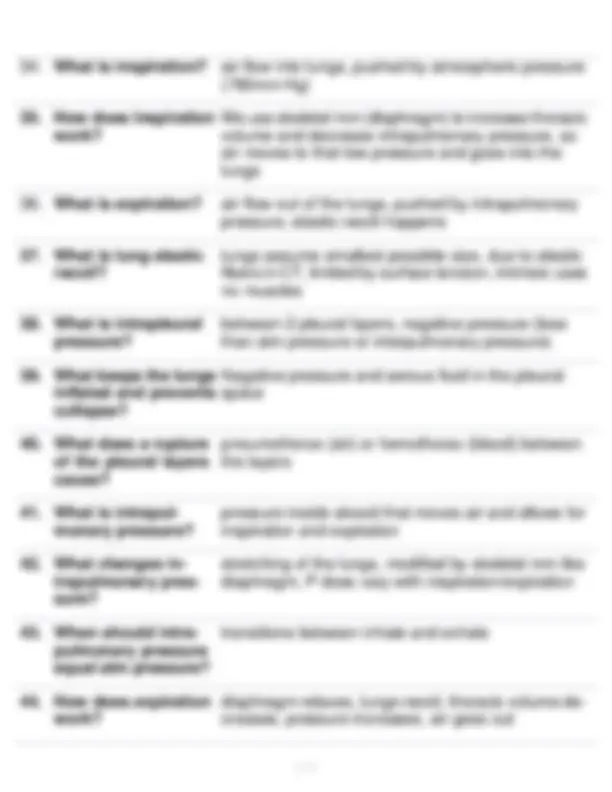
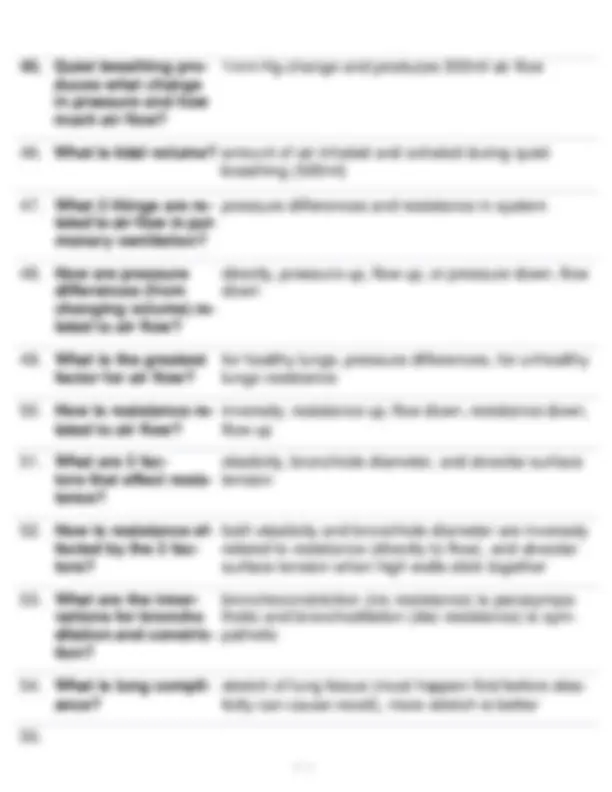
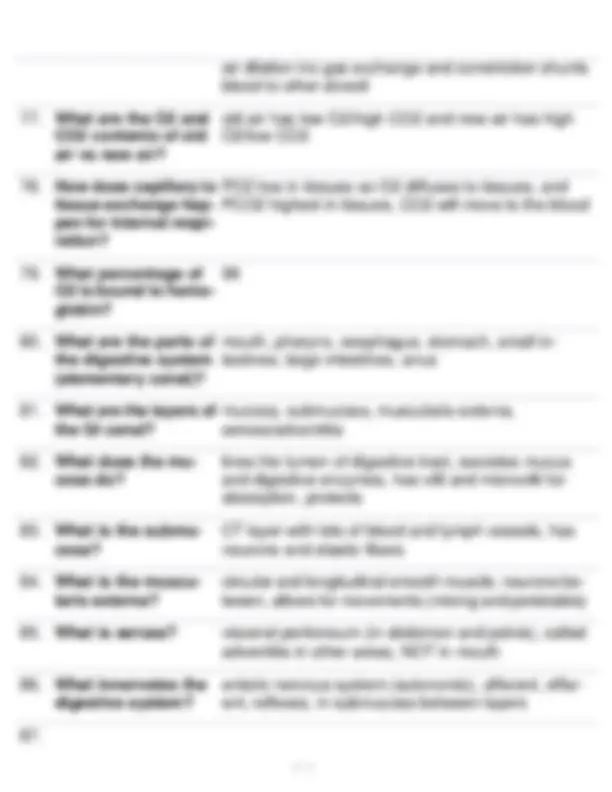
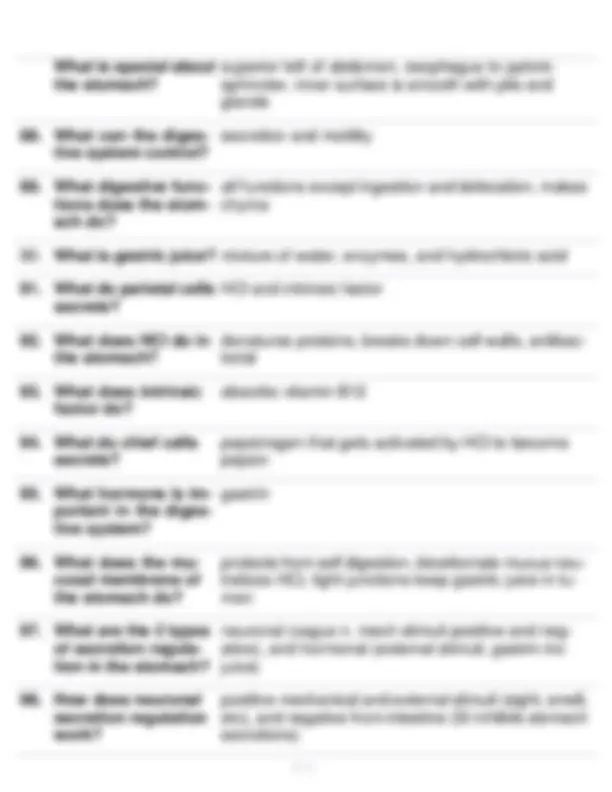
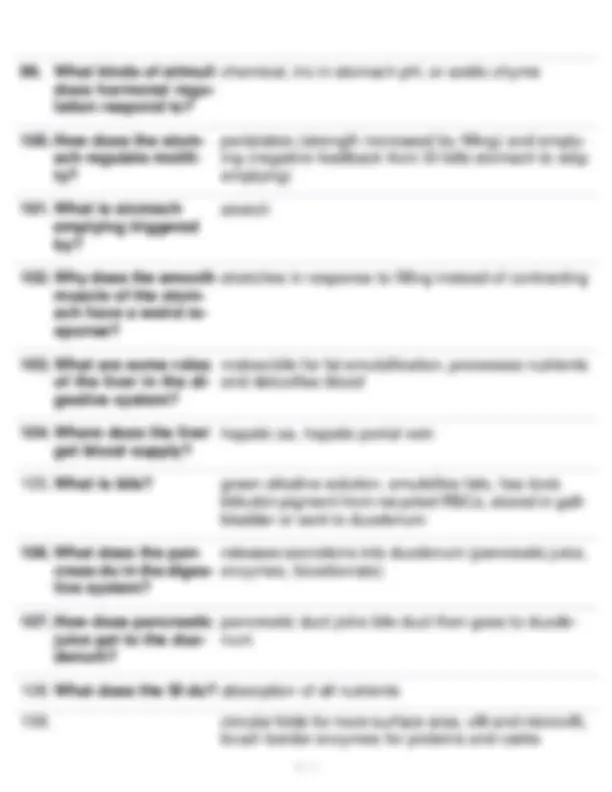


Study with the several resources on Docsity

Earn points by helping other students or get them with a premium plan


Prepare for your exams
Study with the several resources on Docsity

Earn points to download
Earn points by helping other students or get them with a premium plan
Community
Ask the community for help and clear up your study doubts
Discover the best universities in your country according to Docsity users
Free resources
Download our free guides on studying techniques, anxiety management strategies, and thesis advice from Docsity tutors
This comprehensive overview covers the respiratory and digestive systems, including their structures, functions, and key processes. It delves into respiration, gas exchange, and the role of the lungs. The document also explores the digestive system, examining its components and their roles in digestion and nutrient absorption. The information covers a wide range of topics, such as the mechanics of breathing, the composition of air, the structure of the alveoli, and the function of the digestive tract.
Typology: Exams
1 / 11

This page cannot be seen from the preview
Don't miss anything!







Anatomy Unit 4 Respiratory and Digestive Questions & Answers 2024 A+
cleaned, moistened, warmed
gas exchange in the lungs
gas exchange in other body tissues
use of O2/ production of CO2 in cells
epiglottis, thyroid, arytenoid, cricoid
Abduct (open) and adduct (close) cords, volume, cord stretch, pitch
supra and infrahyoids, elevate and depress for swal- lowing
vagus nerve (sensory and motor)
Anatomy Unit 4 Respiratory and Digestive Questions & Answers 2024 A+
mucous membrane lined tube, held open by C shaped cartilage rings, closed by trachialis smooth mm, allows esophagus expansion
cartilage rings or plates, CT with elastic fibers for lung recoil, smooth mm, has internal epithelium w/ cilia
right and left (branch off trachea)
right-3 and left-
secondary, 3 right, 2 left
small are tertiary segments and bronchioles
cartilage, cilia, and mucus decrease, while smooth mm increases
bad
We use skeletal mm (diaphragm) to increase thoracic volume and decrease intrapulmonary pressure, so air moves to that low pressure and goes into the lungs
lungs assume smallest possible size, due to elastic fibers in CT, limited by surface tension, intrinsic uses no muscles
between 2 pleural layers, negative pressure (less than atm pressure or interpulmonary pressure)
Negative pressure and serous fluid in the pleural space
pneumothorax (air) or hemothorax (blood) between the layers
pressure inside alveoli that moves air and allows for inspiration and expiration
stretching of the lungs, modified by skeletal mm like diaphragm, P does vary with inspiration/expiration
transitions between inhale and exhale
diaphragm relaxes, lungs recoil, thoracic volume de- creases, pressure increases, air goes out
1mm Hg change and produces 500ml air flow
pressure differences and resistance in system
How are pressure directly, pressure up, flow up, or pressure down, flow differences (from down changing volume) re- lated to air flow?
What is the greatest for healthy lungs, pressure differences, for unhealthy factor for air flow? lungs resistance
How is resistance re- inversely, resistance up, flow down, resistance down, lated to air flow? flow up
What are 3 fac- elasticity, bronchiole diameter, and alveolar surface tors that effect resis- tension tance?
How is resistance ef- both elasticity and bronchiole diameter are inversely fected by the 3 fac- related to resistance (directly to flow), and alveolar tors? surface tension when high walls stick together
What are the inner- bronchoconstriction (inc resistance) is parasympa- vations for broncho thetic and bronchodilation (dec resistance) is sym- dilation and constric- pathetic tion?
What is lung compli- stretch of lung tissue (must happen first before elas- ance? ticity can cause recoil), more stretch is better
How do gases move? from high pressure to low pressure (down the gradi- ent)
What gas is the most soluble?
Since O2 isn't very soluble in liquid, what happens?
What effects gas movement?
What is the pathway of oxygen to blood?
we need hemoglobin to transport oxygen in the blood (liquid)
partial pressures (not ones bound to hemoglobin) and solubilities
we breathe the air, it goes through respiratory mem- brane, goes into blood but can't dissolve, sucked up by hemoglobin, carried around in blood
went through gas exchange, O2 removed, CO2 and H2O added, levels of old air can be changed by alveolar ventilation (how deep we breathe)
alveoli (lowest in tissues)
tissues (lowest in alveoli)
structure of membrane, perfusion (blood flow), and partial pressures/ gas solubility
with old air vasoconstriction shunts blood to other alveoli and vasodilation cleans out alveoli, with new
air dilation inc gas exchange and constriction shunts blood to other alveoli
What are the O2 and old air has low O2/high CO2 and new air has high CO2 contents of old O2/low CO air vs new air?
How does capillary to PO2 low in tissues so O2 diffuses to tissues, and tissue exchange hap- PCO2 highest in tissues, CO2 will move to the blood pen for internal respi- ration?
What percentage of 98 O2 is bound to hemo- globin?
What are the parts of mouth, pharynx, esophagus, stomach, small in- the digestive system testines, large intestines, anus (alementary canal)?
What are the layers of mucosa, submucosa, muscularis externa, the GI canal? serosa/adventitia
What does the mu- lines the lumen of digestive tract, secretes mucus cosa do? and digestive enzymes, has villi and microvilli for absorption, protects
What is the submu- CT layer with lots of blood and lymph vessels, has cosa? neurons and elastic fibers
What is the muscu- circular and longitudinal smooth muscle, neurons be- laris externa? tween, allows for movements (mixing and peristalsis)
What is serosa? visceral peritoneum (in abdomen and pelvis), called adventitia in other areas, NOT in mouth
What innervates the enteric nervous system (autonomic), afferent, effer- digestive system? ent, reflexes, in submucosa between layers
What kinds of stimuli does hormonal regu- lation respond to?
How does the stom- ach regulate motili- ty?
What is stomach emptying triggered by?
Why does the smooth muscle of the stom- ach have a weird re- sponse?
What are some roles of the liver in the di- gestive system?
Where does the liver get blood supply?
chemical, inc in stomach pH, or acidic chyme
peristalsis (strength increased by filling) and empty- ing (negative feedback from SI tells stomach to stop emptying)
stretch
stretches in response to filling instead of contracting
makes bile for fat emulsification, processes nutrients and detoxifies blood
hepatic aa, hepatic portal vein
releases secretions into duodenum (pancreatic juice, enzymes, bicarbonate)
pancreatic duct joins bile duct then goes to duode- num
What are some modi- fications the SI has to do its job?
intestinal juice
uses tight junctions, most by active transport (water passive)
are co transported with Na+
bypass liver, group with bile salts, diffuse, reformed and recycled, enter lacteals to go to blood, broken down again
pancreatic enzymes
storage and elimination of feces, absorbs water, mass movement (peristalsis after meals)
rectum walls stretch, reflex relaxes internal sphincter, skeletal muscle controls external sphincter (motor neurons voluntary)
visceral, parietal, mesentery, greater and lesser omentum